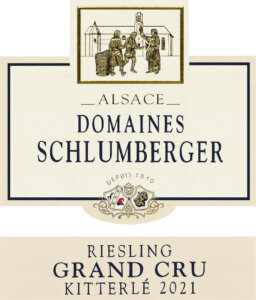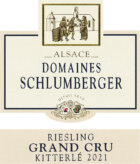History
Ranked among the best wines in the world, the Riesling is one of Alsace’s biggest successes. Introduced in the 15th century, and originating from the Orleanois region, it is different from its German counterpart and from the numerous Riesling, which can now be found a little all over the world. A late-ripening grape variety, it continues to ripen at low temperatures, but gives marvelous results when there is a sunny, dry, late summer. First distinguished in 1699, Kitterlé has always had an exceptional reputation. Already protected in the middle ages, it has been sold under its own name since 1830.
Location
This volcanic-sandstone plot is on a unique site, on a steeply sloping rocky outcrop facing three ways (south-west, south and south-east). The light, sandy soil, which is kept back by huge dry stonewalls, only gives very low yields (25 to 35 hl/ha)
Wine-making
The grapes are handpicked and whole bunches are pressed. There is static settling of the lees. The wine is fermented in temperature-controlled tuns, followed by raising on the less for 8 months.
Gastronomy
At the table, I like to pair it with a millefeuille of pike-perch with fennel confit, smoked trout in a citrus sauce, grilled lobster tail with spiced sweet potato purée and tarragon cream, or goat’s milk cheese…
Serving temperature: 12°C.
This wine goes well with
Learn more about food & wine pairingTasting
The colour is lemon-yellow with light reflections of good intensity. The disk is bright, limpid, and transparent. The wine is youthful.
The nose is frank, pleasant, and subtle. Fruity aromas dominate, with citrus, bergamot, lemon, fine vegetal and white flowers.
Aeration amplifies these scents, revealing lemongrass, spices, ginger and an airy, smoky, naphty mineral register. As usual, the Kitterlé expresses itself superbly. Elegant and delicate, the terroir is there. A great success.
The attack on the palate is dense, with a full-bodied alcohol base. The mid-palate is incisive, marked by pearlescence. We find the same range of aromas as on the nose, still focused on fruit, citrus, lemongrass, bergamot, fine vegetal, white flowers, spices, ginger, and that mineral touch of naphtha.
There’s a hint of bitterness. The finish has great length, 11-12 caudalies, as well as strict vivacity and a slight, persistent bitterness.
The balance is slender, but reminiscent of the mineral profile of the place.
The range of aromas reinforces the wine’s dimension. Excellent !!!
Technical sheet by M. Pascal Leonetti: “Best Sommelier of France 2006” February 2024















